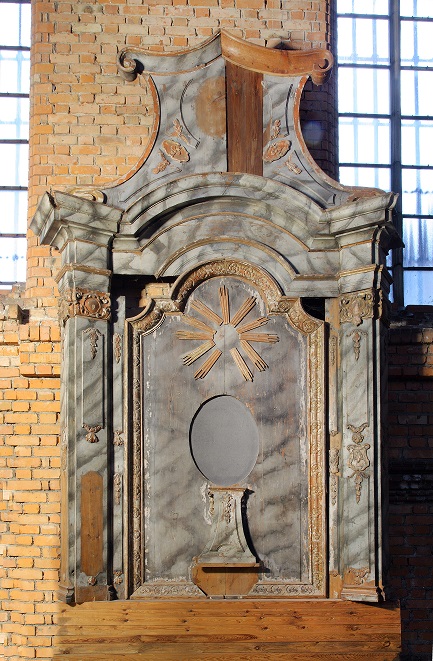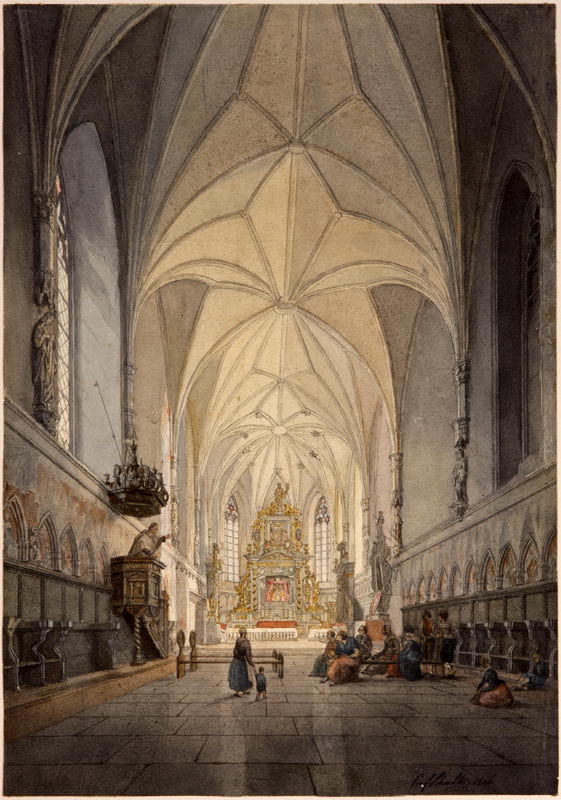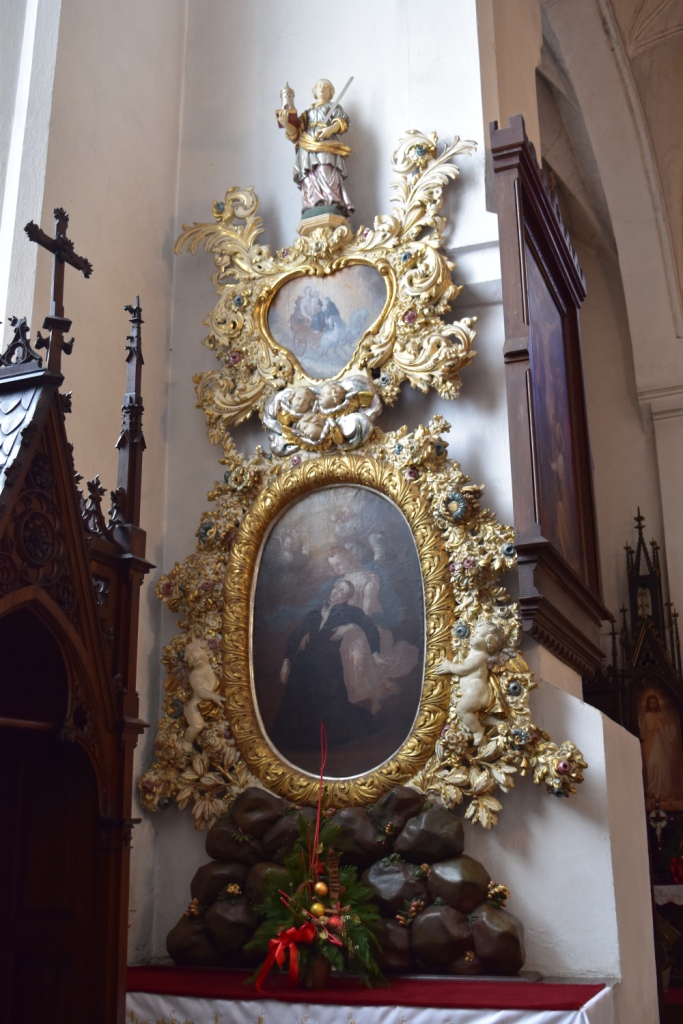Members of the Society of Jesus, brought to Malbork in the first decade of the 17th century by the bishop of Chełmno and Pomezania – Jan Kuczborski (approx. 1572–1624), in 1666 took over the use of the Church of the Virgin Mary with the chapel of St. Anna at the High Castle. They started the process of baroque modernization of the gothic interior of the castle temple to the needs of the Roman liturgy, which was gradual and largely dependent on the funds granted to them from the Malbork Economy and the material support of wealthy donors.
In the first phase, until 1675, basic adaptation and renovation works were carried out both inside and outside the church, enabling the monks to start their pastoral activities. All walls were whitewashed. The windows were repaired and clear glass panes were inserted into them. New elements of equipment were introduced and four smaller altars were incorporated into the temple space and the famous painting Beatae Mariae Virginis. was transferred from the gate chapel at the St Mary’s Tower (located in the southern part of the city’s defensive walls) to the fifth altar (of Teutonic origin).
In the following decades of the 17th and 18th centuries, further changes took place in the furnishings of St Mary’s Church. In the years 1687–1696 a new main altar was built, which was referred to in the Chronicle of the Jesuit Residence as the “Great Altar of the Miraculous Virgin”. Its high architectural retable was filled with the entire height of the polygonal closure of the eastern span of the temple, harmoniously fitting into the structure of the Gothic interior [Fig. 1]. New side altars were also built. The Inventory of the Malbork Castle from 1764 shows that there were five smaller altars in the Church of the Blessed Virgin Mary at that time. They bore the following invocations: the fathers of the Jesuit Order – St. Ignatius of Loyola and St. Francis Xavier, St. Stanisław Kostka, St. Antoni Padewski and St. Joseph. Patros of the settings from the first two (twins in their construction), funded in 1738 with donations from many people, remained in the collection of the Malbork museum [Fig. 2].
In the next century, after the dissolution of the Jesuit order by Pope Clement XIV, changes took place in the furnishings of the Church of the Blessed Virgin Mary. From the inventory from 1830 (found by Rev. Professor Wojciech Zawadzki from Elbląg) we learn that in the castle temple in the so-called “Romantic restoration” there were only three smaller altars – St. Ignatius of Loyola, St. Francis Xavier and St. Antoni Padewski. This fact is also documented by the oldest iconographic source from the 1840s – a colorful watercolor with a view of the interior of the church towards the east by the Gdańsk painter Johann Carl Schultz [Fig. 3]. The other two altars – St. Joseph and St. Stanisław Kostka (pursuant to the decision of November 9, 1807) were transferred from the Teutonic Knights stronghold to the parish church under the invocation of st. John the Baptist in the Old Town.
Katarzyna Wardzyńska, a Warsaw researcher specializing in modern art in the former Polish-Lithuanian Commonwealth, in one of her articles published in the passing decade, attributed the authorship of the altar of St. Stanisław Kostka [fig. 4], who today stands in the chapel of the northern nave of the Malbork parish church, Johannes Söffrens (1660 – after 1721), a sculptor with Dutch roots active in Elbląg in the years 1691–1721. The altar bearing the patrocinium of a Polish saint who died young in Rome in 1568, canonized by Pope Benedict XIII in 1726 – as noted by an anonymous Jesuit chronicler – was first mentioned (almost completely) in 1685. This investment was financially supported by Malbork councilors: Brauser , Habman and the notary of the castle courts and the economist of Malbork – Braun. Another “modernization” of it, donated by Mr. Repiński, also known only by his last name, took place at the end of 1701, and the paintings for him were ordered by the superior of the Malbork residence, Jan Taube (1659–1708) in the distant Toruń. The location of this altar in the castle temple could have been the northern wall of the presbytery, there is an empty space or (as the archival sources suggest) on the Schultz watercolor on the axis of the altar of St. Antoni Padewski. However, this issue requires further detailed research.
The altar setting of the saint patron of Catholic youth, made by a master from Elbląg, is characterized by a light form. A “stone pedestal” rests on the walled (rectangular) mensa, which is the basis for the rich floral and figural settings of two Toruń paintings. In the central part there is an oval painting showing the death of St. Stanislaus. The composition above shows the scene of the Jesuit saint being accepted to heaven by the Madonna, in a “heart-shaped” field. At the top of the retable there is a figure of St. Barbara – the patroness of good death.
Up to 1880s and the beginning of the next reconstruction by Konrad Steinbrecht (1849-1923), there was an altar of St. Antoni Padewski, founded by the Kulesz family in 1684, and in 1715 most likely replaced with a new one [Fig. 5]. Today it is considered a lost work. Its sculptural setting (despite the poor legibility of the archival photo) shows many analogies with the post-Jesuit retable in the Old Town parish church and we can, with a high degree of probability, attribute its authorship to the Elbląg master. Around 1910, fragments of the altar setting were stored in an attic warehouse in the west wing of the High Castle, which housed a collection of Chinese architectural details [Fig. 6].
On the stone mensa of the altar of the ascetic of Padua there was a low predella with painted figural decorations in the panels, depicting scenes from the life of the saint Franciscan. Above, in a decorative wooden frame, there was a painting with a full-figure image of St. Anthony with the baby Jesus. At the bottom it had the shape of a cloud with winged heads and busts of angels integrated into it and on the sides it took the form of a wide plant composition of acanthus and laurel. At the top, in the second story, in a “heart-shaped” field, there was an undefined painting. At the top of the altar, there was a full-body sculpture showing an unrecognized (ego) saint (ego) holding a lily in his hand (?).
(opr. J. Lijka)
ILL. 1. View of the interior of the Church of the Blessed Virgin Mary in the High Castle towards the east (fragment); archive photo from the collection of the Castle Museum in Malbork, Marienburg Baujahr 1882–1885, ill. 12; rep. L. Okoński.

ILL. 2. Remains of the regency retable from 1738 from the Church of the Blessed Virgin Mary; from the collection of the Castle Museum in Malbork; 1st decade of the 21st century; photo by L. Okoński.

ILL. 3. Johann Carl Schultz, View of the interior of the Church of the Blessed Virgin Mary in the High Castle towards the east; watercolor from the collection of the Castle Museum in Malbork; photo by L. Okoński.

ILL. 4. The northern nave in the church of St. John the Baptist in the Old Town with the altar of St. Stanisław Kostka; contemporary photo; photo by B. Butryn.

ILL. 5. View of the interior of the Church of the Blessed Virgin Mary in the High Castle towards the west; archive photo from the collection of the Castle Museum in Malbork, Marienburg Baujahr 1882–1885, ill. 13; rep. L. Okoński.

Il. 6. Ołtarz św. Antoniego w magazynie chińskich detali architektonicznych na poddaszu w zachodnim skrzydle Zamku Wysokiego; fot. archiwalna ze zbiorów Muzeum Zamkowego w Malborku, Marienburg Baujahr, 1910, il. 5; rep. L. Okoński.

